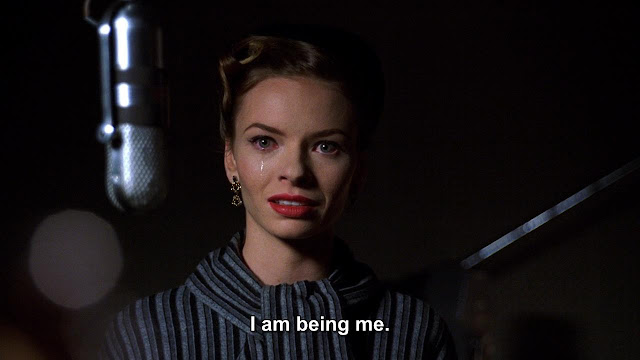by Will Ross
---
At the close of season 1, the most surprising thing about Mad Men may be its near-freeform structure. The slow reveal of Don Draper’s true past has its climax in episode 12, when the detestable Pete Campbell unsuccessfully blackmails him for a promotion, but episode 13 finishes the season by climaxing the respective arcs of Betty and Don — and neither has anything to do with Dick Whitman. That sensational backstory, the closest thing season 1 has to an A-plot, melts into the fabric of the series, as the family lives and lies of other Sterling Cooper employees are given nearly equal import. Don Draper’s biggest sin isn’t leaving parents who didn’t care for him, it’s that he’s so willing to abandon the family who needs him, be it his wife and children or his desperate brother Adam.
Adam’s suicidal trajectory is set properly in motion by Don: believing he is giving his brother the same opportunity to start over that he had, he offers Adam $5,000 and shoos him out the door. Months later, Adam hangs himself. Draper is shocked, and he bears the weight of the season’s moral: you can’t placate a long-lost brother with a severance package; you can’t conduct adultery like a backroom transaction; you can’t treat your whole life like a business.
Given that, it’s hard to imagine that the series sympathizes at all with Burt Cooper’s objectivist ideals. Nor, for that matter, does Draper. After Cooper insists that Draper read Atlas Shrugged, there’s scant evidence that he ever does. When Pete throws a tantrum over Peggy being promoted, Draper observes that he is letting his personal jealousies interfere with business and says, “You’ll have to give back that copy of Ayn Rand.” Not, “that copy of Atlas Shrugged.” Could this be shorthand for the sake of Pete (and the audience)? Maybe. But Mad Men makes a conspicuous point of showing what its characters read: the office women read Lady Chatterley’s Lover, Cooper reads Atlas Shrugged, Draper reads (albeit uncomprehendingly) Exodus and, in the season 2 premiere, Frank O’Hara’s Meditations in an Emergency. Draper is never seen reading Atlas, and why would he? The man has little patience for moralizing; I can’t imagine he would appreciate it in novel length.
My point is not to project my own disdain for Rand onto Draper. Though I suspect Mad Men’s writers share my moral objections, Draper’s own objections tend to be on the grounds of nihilism, not moralism. It’s likely that he views Rand’s ilk much the same way as he views Midge’s hippy cadre: as uppity activists, fruitlessly convinced that their ideals can alter the world’s unflinching and apathetic course.
Of course, they will change the world in the coming decade, and hints of that are scattered throughout the season. Perhaps most noticeably, black people are conspicuously backgrounded. From the pilot’s first scene onwards, they make sporadic appearances, always in low-paying, unglamorous jobs, and always quietly enduring, in some way or another, the casual racism of well-to-do whites. No one — absolutely no one — shows any negative reaction to that racism, except when Paul Kinsey insults the fashion sense of a lunch cart worker.
Put simply, the men try to capture everything they can, and the women try to break free. But Betty Draper, the show’s central figure of patriarchal control, self-destructively collides these symbols and their respective meanings: in episode 9, when she tries to reboot her modeling career and reclaim some independence, she fails (her burgeoning career was being held hostage to lure Don to another agency), and the episode concludes with her resentfully sniping at fleeing pigeons.
But for all the dynamite imagery of that moment, Betty’s conflicted mental state also manifests in more subtly visual ways. Take, for instance, the moment in episode 7 when Don is out of the room, and Roger makes a pass at her.
Betty enters the frame with her back to the camera and into a composition that is unbalanced, both in its messy post-meal set dressing and its heavy weighting towards the right, creating frailty and tension.
The camera movement completes as the conflict comes into full view. Betty's face is revealed in pointed profile. As Roger puts his hand on Betty, she leans away above the waist (towards her initial far-right position) — but again, the ass says it all.







0 comments:
Post a Comment